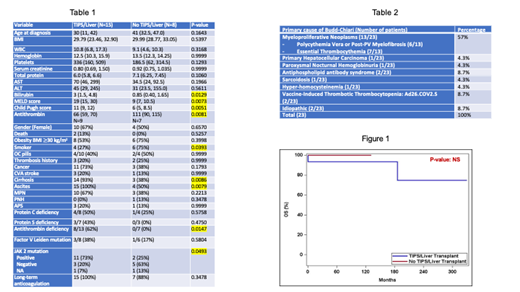Abstract
Background: Budd-Chiari Syndrome (BCS) is a complex thrombotic disorder caused due to obstruction of hepatic venous outflow involving anywhere from small hepatic venules to the entrance of inferior vena cava into the right atrium. This leads to venous stasis and ischemic injury of hepatic parenchyma and sinusoids, with the risk of liver failure. The prognosis of patients with BCS had improved significantly with long-term anticoagulation and measures like Trans-Jugular-Intrahepatic-Porto-Systemic shunt (TIPS) and liver transplantation. We report the outcomes of patients who follow in our hematology practice and describe the factors predicting the need for TIPS/Liver Transplant.
Methods: After appropriate Investigational Review Board permission, we identified patients with a history of BCS following in our thrombosis clinical practice from the year 2010 onwards. We evaluated their laboratory, demographic, anticoagulation data, Model of End-stage Liver Disease (MELD) score, Child-Pugh (CP) score at diagnosis or when earliest available, and other relevant clinical information as outlined. Descriptive statistics with medians, quartiles, frequencies, and percentages are reported. Further, we compared the two categories of patients who needed TIPS/Liver transplants versus those who did not. SAS version 9.4 was used for analysis. For continuous variables, a univariate nonparametric Mann-Whitney test was used. The Fisher's Exact Test was used to associate each variable with the need for TIPS/Liver Transplant.
Results: Our study included 23 patients with baseline characteristics, including median age of 36 years (11-59 years), 91% whites, 61% females, 44% smokers, 61% obese(median BMI 29.9 kg/m 2), 6 of 14 women on oral contraceptive pills, 22% with thrombosis history, 17% with stroke history, median hemoglobin 13.4 gm/dL(8.9-20 gm/dL), white blood cell count 9,400/L (3,050-31,500/L), platelet count 294,000/L(14,000-767,000/L), serum creatinine 0.87 mg/L (0.55-2.52 mg/dL), total protein 6.3 gm/dL (5.2-8.8 gm/dL), Bilirubin 2.1 mg/dL(0.1-20.2 mg/dL), Aspartate Aminotransferase (AST) 61 U/L(16-1037 U/L), Alanine Aminotransferase (ALT) 43U/L(18-1694 U/L), MELD score 15 (range 7-38), CP score 9 (5-14), 74% with cirrhosis, 82% with ascites at one point, 57% with myeloproliferative neoplasm (MPN), 4.3% with Paroxysmal Nocturnal Hemoglobinuria (PNH), 17% with Antiphospholipid antibodies positive (APS), 13% had positive antinuclear antibodies, 35% needed TIPS and 44% required liver transplantation. 57% with Janus Kinase (JAK2) V617F mutation (1 patient with a low variant allele frequency of 1%), 1 patient (4.3%) had Calreticulin (CALR) mutation positive MPN, 91% remained on long-term anticoagulation with 40% using warfarin, 35% apixaban, 9% Enoxaparin or Rivaroxaban for long-term anticoagulation, 13% developed heparin-induced thrombocytopenia (HIT). 8.7% had developed BCS after Ad26.COV2.S vaccine to prevent SARS-CoV-2 infection. Excluding the patients with missing variables, 5 of 12 had Protein C deficiency, 3 or 10 had Protein S deficiency, 8 of 20 with Antithrombin (AT) deficiency, 4 of 14 with heterozygous factor V Leiden mutation, 0 of 10 with prothrombin gene mutation, 1 of 13 with hyper-homocysteinemia. 35% had gastrointestinal bleeding though 65% of patients had evidence of varices by endoscopy. When the group needing TIPS/Liver transplant/died is compared to those who did not, they had higher bilirubin, MELD, PC score, AT deficiency, cirrhosis, ascites, and JAK2 mutation (p-value significant: Table 1). With a median follow-up of 90 months, overall survival was not statistically significant between the two groups (Figure 1). Two patients (8.7%) died out of a total of 23.
Conclusions: Our data indicate that in patients with BCS, neoplasms (61%), particularly MPN (57%), are very commonly diagnosed. Compared to the historical data in patients with BCS with dismal prognosis (60-80% six-month mortality rate), the overall survival had significantly improved, likely due to supportive measures like TIPS/Liver transplant and long-term anticoagulation. Outside the established variables like CP and MELD, lower antithrombin activity and positive JAK2 mutation status also predicted a higher TIPS/Liver transplant need.
Bhatt: Partnership for health analytic research, LLC: Consultancy; Abbvie: Consultancy, Research Funding; Jazz: Research Funding; Incyte: Consultancy, Research Funding; Pfizer: Research Funding; Tolero Pharmaceuticals, Inc: Research Funding; National Marrow Donor Program: Research Funding; Abbvie: Consultancy, Research Funding; Genentech: Consultancy; Servier Pharmaceuticals LLC: Consultancy; Rigel: Consultancy. Gundabolu: BioMarin Pharmaceuticals: Consultancy; Blueprint Medicines: Consultancy; Bristol-Myers Squibb Company: Consultancy; Pfizer: Research Funding; Samus Therapeutics: Research Funding.


This feature is available to Subscribers Only
Sign In or Create an Account Close Modal